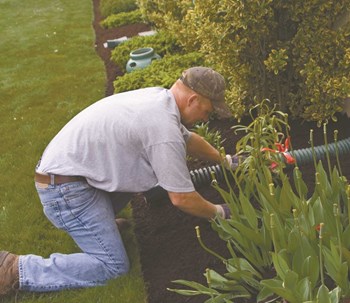
How many times has a property manager been asked “What is it that you do, exactly?” The answer is really simple—a property manager wears all the hats required to administer an account and keep a property in tip-top shape. As daunting as this may seem, there are some aspects of the job that can be really fun. While many mangers leave their properties' landscaping up to the landscaper or the landscaping committee, a manager with a little knowledge can make the annual spring walk-through and the recommendation process much easier and a lot more fun.
Appearance vs. Reality
While most managers have not formally been trained in plant identification, much less proper plant placement, there are several easy tools that any manager can acquire to know what they're looking at and have challenging, meaningful discussions with a landscaper or landscape committee. Although even a well-informed property manager should not take the place of a bona fide plant expert, a knowledgeable manager can make many educated recommendations to their board.
When you are considering the community landscape as a whole, it is crucial to start with the most basic element—the soil. It is important to understand the development process. Once building is about to commence, developers typically sell the top soil from a site before development even begins. The bulldozers clear the site of all buildings and trees and pile the topsoil in one area in preparation for construction. The rich topsoil, full of nutrients, is sold to various enterprises that will sterilize it and either bag it and sell it in the consumer market or sell it in bulk to wholesalers for use in landscaping. There are hundreds of uses for good, rich topsoil and developers rarely fail to tap this potential source of revenue. This practice, however, eventually causes major problems for the newly-built community. Since the topsoil is never replaced, the community is left with coarser, non-nutritious subsoil throughout its grounds. The developer may sod the fronts of the units and seed the rear of the units—and this, combined with all the new plantings installed at the end of the building process, makes most new communities look like they have vibrant soil and healthy plant material.
Appearances are deceptive, however. The course subsoil will support some turf and plant material, but more often than not, the grass and plants will start to show signs of stress after a few years. Once a community manager is aware that the soil conditions are not quite the ideal everyone assumed, there is only one thing to do—test the soil. The best place to start is with the local county Agricultural Extension office.
Do Soil Testing
Each state has a network of Agricultural Extension offices that are part of the state land-grant institution. In 1862, the Merrill Act provided grants to each state to establish public institutions to teach agricultural and mechanical arts. In 1864, Rutgers University was designated the land-grant college of New Jersey. Cook College, now called the School of Environmental and Biological Sciences, was the land-grant college at Rutgers. This college at Rutgers has been carrying out the land-grant mission since its inception in 1864.
In 1880, Rutgers established the New Jersey Agricultural Experiment Station (NJAES). The NJAES has two functions: first, to conduct research and second, to educate and help residents of the state with their agricultural needs. Over the years, the number of commercial farms in New Jersey has decreased, while the numbers of home-farmers and gardeners are on the rise. Keeping up with this trend, the NJAES has expanded its services outside of the farming industry. This is good news for the community manager, or anyone else with a gardening or landscaping problem. In fact, the NJAES has been testing soil for state residents since 1860. George H. Cook (the namesake of Cook College) was a soil scientist involved in the chemical analysis of soils and fertilizers. Today, anyone can get the benefit of the research conducted at Rutgers through the NJAES.
To get soil tested is an easy process. The main Rutgers soil testing website will lead to the individual county offices. Property managers should start by contacting the local office to discuss what is needed and to purchase the soil testing kit. Remember: conditions are not always the same throughout a development, so more than one test may be needed. The main website for soil testing servicse is found at http://njaes. rutgers.edu/soiltestinglab. The fees range from $15 for a very basic test to $75 for a more in-depth diagnostic test. Specialty tests will cost more but are not usually needed. There is a plant diagnostic test for $40 and a topsoil evaluation for $75. These are the most common tests that are of most use to a typical property manager. Once the results are received, the community manager can discuss them with the county extension agent to determine the conditions for the community.
Light and form are two additional factors to consider in determining proper plant placement. It is important to know the light requirements of any desired plantings and make sure they match the conditions in the community. Knowing the plant’s form is also crucial to the planning process. As shrubs and trees grow, they may not be as suited to the site as they are today. There are many websites and books that can help with these questions.
One such website is www.cnr.vt.edu/dendro/dendrology/factsheets.cfm, and comes from the Dendrology (the study of trees) department at Virginia Tech. It is an easy-to-navigate site that allows the user to put in the common name of a tree to get a comprehensive fact sheet. This fact sheet will discuss growth habits, lighting requirements, soil requirements and other environmental factors affecting the growth of the tree. There are also pictures to show the mature form of the tree.
Another great government website, http://plants.usda.gov, is for the slightly more knowledgeable plant person. The information is good and comprehensive with great images, but a basic knowledge of plants is helpful. And www.arborday.org/index.cfm is a wealth of information on anything tree related including pruning, global warming and how to pick the right tree. There are great plant-specific sections that include information on soil type, sun exposure and form.
Finally, if you're staring out a window at a common lawn sprouting all manner of unwanted plant life, the website http://weedid.aces.uiuc.edu/index.html is a fascinating compendium of all things weed-related. The user is presented with a number of selections to pinpoint the exact name and habits of their problem weed. The more you know about the weed plant the better you will be able to use this site.
Read All About It!
There are also numerous books that are wonderful resources, some very simple to use. A company called Fandex publishes cards clipped together that can be fanned to the right card. The fan on trees is especially good. The top of the card has a cutout of the leaf of the tree so you can easily ID a tree as you are walking by. The card itself has a lot of information on the tree. A leaf from a tree can easily be matched to the card. If more information is needed, it can be gotten on the web. This is an easy to carry, handy tool that should be in every management office.
Right Plant, Right Placeby Nicola Ferguson is a wonderful book with lots of information on numerous trees and shrubs. The real value of this book, however, is the way in which the plants are categorized. The book is broken down into chapters such as “Plants suitable for heavy clay soils” or “Plants suitable or damp or wet soil.” There are even design recommendations such as “Plants with variegated leaves” or “Plants with aromatic leaves.” Again, this is an invaluable guide! Imagine saying to the board “There are several trees or shrubs that might work in that location such as ___. Do you want me to check with the landscaper on these?” Knowledge is indeed a powerful tool.
Remember—you don’t need to know everything about plants and trees. A basic knowledge, however, will go a long way in making the manager’s job a lot easier and a lot more fun!
Mary Faith Radcliffe, CPM, AMS is a accredited property manager with RCP Management Co. in Princeton.





Leave a Comment